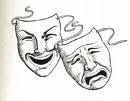An element of drama is plays. Actors act out the play by using dialogue which is found in the script of the play. Some act out drama in theaters. The most important things needed to perform are a stage, lights and a theater. The stage is important because it is elevated so everyone can see the play clearly and allows actors to change without being seen. The lights are important because it helps you focus on who is talking or to catch the audience’s attention.
The actors follow the stage directions given by the director of the play. Stage directions are the emotional and physical intentions of the characters. Every drama/story has seven themes. These themes are: tragedy, bravery, heroism, family, revenge, love, redemption and war.
Every drama also has an exposition, rising action, a climax, a falling action, and a resolution. These are all called elements of plot. An exposition gives you the back up information so you can understand the play. A rising action leads up to the problem/conflict. A climax is when the problem/conflict is introduced; it’s the most important part of the play because it can change the whole outcome of the play. A falling action is when the conflict is almost solved. The resolution is the outcome of the play where a solution is made whether good or bad.
Costumes are very important in every play because it helps you learn more about the characters. This is why every play usually has a costume designer that finds or designs the costumes for the actors to wear. For example if a actor is wearing a bustle gown then the play is taking place in the victorian era.
Every play is broken up into scenes. A scene is a short story in a play. Each scene focuses on different themes and they are all important.
Wednesday, March 3, 2010
Subscribe to:
Post Comments (Atom)



No comments:
Post a Comment